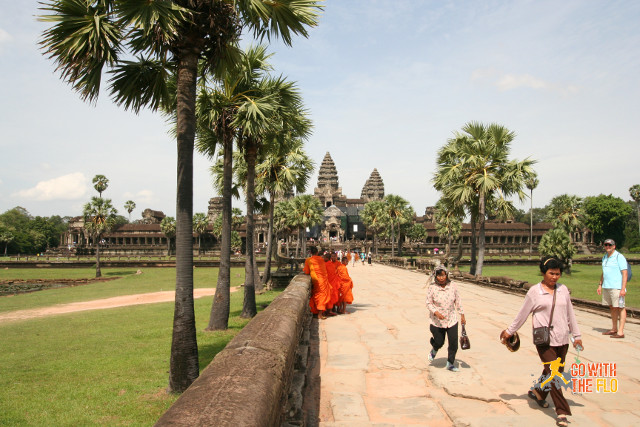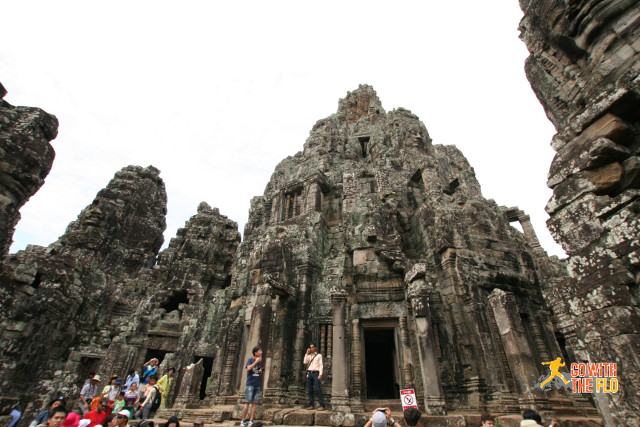Thoughts on visiting Angkor Wat
I’d say there isn’t a single historical area with a larger “wow” factor than Angkor Wat. There may be monuments that are almost out-of-this-world spectacular. However, what sets Angkor Wat apart is the sheer size and number of buildings that are out-of-this-world spectacular. In case you haven’t been (which I guess is why you are reading this), imagine the Taj Mahal (which is so iconic that probably most people have it in front of their eyes) and then imagine a large area with literally dozens of Taj Mahals in different shapes and forms all over the place. That could come close to Angkor Wat. Granted, most buildings aren’t in as great shape as the Taj Mahal but you get the idea.
Neglected and off limits during the regime of the Khmer Rouge, Angkor Wat has only gotten back on the tourist map in the late 1990s. But the real surge in tourism only started around 10 years ago. I visited off-season in 2009 and while crowded, the tourist numbers where nowhere near to what I experienced this year. If you haven’t been, go now or wait until the authorities implement some kind of crowd control measure (Machu Picchu for example does a fairly good job at this).
This blog post will share my thoughts on how to be approach your visit. You might want to read about my travel style as you might approach things differently.
When to go
Take my advice and go during off season. The weather might be very hot and humid and it might rain (actually it should as otherwise the farmers will suffer). However, by now you absolutely want to avoid the crowds during peak season. Even though the area of interest is huge, people congregate at the main temples and you end up pushing and shoving each other. Despite lots and lots of hotels being built, hotel rates surge by 20-30% and it can even be difficult to find a (good) tuk-tuk driver during high season. I’ve now been twice in July/August and would recommend it.
How to get there / where to stay
Back in 2009 Bangkok Airways still had more or less a monopoly to Siem Reap airport and we travelled overland. Although it was exciting at the time, it is not a particularly scenic drive and I wouldn’t do it again now that low-fare airlines fly into Siem Reap (the town whose sole reason for existence seems to be the temples of Angkor Wat). Hence unless you feel particularly adventurous (if coming from Thailand) or coming from Phnom Penh, just fly. The airport is around 20 minutes outside of town on National Highway 6 and it is easy and quick getting into town.
There are hundreds of accommodation options and you know where to get your recommendation on the internet. In terms of location, you can either stay fairly close to the “centre” of Siem Reap (with its restaurants, bars and markets), along Highway 6 (which is basically just the main road of the town) or along the road towards the temples. Even though not all is walkable, it doesn’t matter so much where you end up since tuk-tuks are everywhere and cheap (round US$2 for a trip in the city).
How to approach your visit to the temples
First of all I’d say that less than two days don’t do the temples justice. Other large religious sites, such as the temples of Hampi in India or Prambanan on Java, can be visited in one day if one wants to. In Angkor Wat this would be a bad idea – the number of breathtaking temples is just so large and the variety so big that you’d not want to squeeze everything in one day but instead buy a three day pass (US$40).
There are various options to visit the temples, ranging from renting a bicycle, to hiring a tuk-tuk or a proper car. All options you can do with or without a guide. In both my visits I rented a tuk-tuk without a guide and do it again this way for a number of reasons:
- Tuk-tuk is the right mix between going very slow (bicycle) but not as fast as in a car so that you can still appreciate the ride and the scenery
- The place is big and the tuk-tuk lets you cover more ground
- You can pack up to four people into a tuk-tuk comfortably, so it can end up fairly cheap (more on that below)
- Especially during off-season, it can get very hot (>30°C with high humidity) – as good as the exercise can be on a bicycle… you will struggle.
- I decided against a guide because the impressions are so overwhelming already and the days can be exhausting that I don’t think I’d be able to absorb much of the information given. I prefer to read up before the visit and then again after having visited. If you do take a guide, be prepared to cover less ground.
How to find a tuk-tuk driver
Don’t worry, you won’t have to search for them – they will find you. There are hundreds of tuk-tuk drivers, waiting along every road of Siem Reap. You’ll be offered a ride every five meters at least. Often people end of taking a tuk-tuk inside Siem Reap and end up sticking with the driver for the rest of their visit if they like them.
I did this during my first visit. While the driver spoke very little English and made excessive use of the tuk-tuk’s horn, he was reliable. This year I went with the recommendation of a friend and booked a driver beforehand. There are also some savvy drivers who have gone to Tripadvisor or built their own websites. While you have a higher chance of knowing what you’ll get, you’ll also likely pay a premium. The basic rate for the main temples seems to be around USD12-15 nowadays. If you want to go to the temples further away (around 30km, i.e. almost an hour drive) or want to stay longer in the evening for the sunset, you might be charged an additional USD5.
Our driver, Mr. Pheng Kunthea (his contact details can be found at http://www.angkortuktukdriver.net) , charged us US$45 for a two day tour that went to the temples further away as well stayed with us to see the sunset. Stay tuned for a post on our tour. He was reliable, friendly and spoke English well. Don’t expect a tour guide for the money however.
Things to remember
- Prepare for the climate: It can get very hot and will always be humid. If the sun is out it can get brutally hot. Bring plenty of water (our driver carried over two liters per person per day with him) but you can buy drinks around the temples
- Avoid the crowds as much as you can: no matter what season, it will always be crowded. But it will we super crowded at the Angkor Wat temple at sunrise/sunset. Besides the main temples, also visit at least one of the lesser known temples and enjoy some time alone
- Don’t get annoyed by the tourism: Siem Reap probably only exists because of tourism. I found it impossible to find non-touristic corners. Every restaurant will cater for tourists. Accept the fact and don’t get annoyed by the hundreds of t-shirt and cold drinks seller. Don’t get annoyed by inflated prices (for Cambodian standards) or bad-value-for-money food around the temples
- Don’t forget how awesome this place is: keep reminding yourself how old the temples are and how much of a masterpiece it was constructing them
If you haven’t been, start planning your visit! If you have any advice for seeing the temples, please feel free to share in the comments.








Thanks so much for Mr, Floran wh had used my tuktuk service while you were here.
I was very satified and very appreciated to service you more and more, specially for your next trip.
I wish you and your family to have sucess, happiness and healthy.
Thanks so much for Mr, Florance who had used my tuktuk service while you were here.
I was very satified and very appreciated to service you more and more, specially for your next trip.
I wish you and your family to have sucess, happiness and healthy.
Dear Mr,
I would like to tell you more on now, I got Car for tour operators tour service too, please give us to recommend to your friends.
http://www.angkortuktukdriver.net